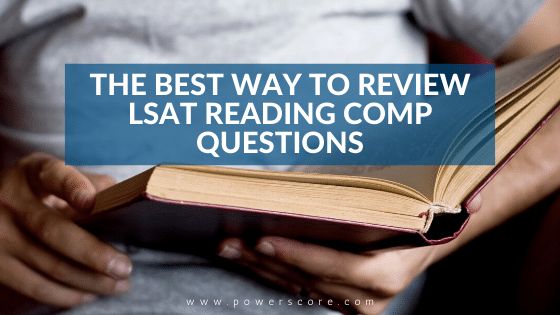There are many excellent resources that discuss how to review LSAT questions in general, but few discuss the best ways to specifically review Reading Comprehension questions. It can be tough to review a full passage and 5 to 8 questions, so let’s discuss what you should be doing.
Understand the Passage
This may seem rather obvious, but it’s often an overlooked part of Reading Comprehension review. Go back and re-read the passage, and as you go through each line, make certain you understand what was said. Paraphrase and simplify each sentence and put it in your own words, because if you can’t do that then you do not understand what the author said. For extremely difficult sections or portions you do not understand, write down a summary. Remember, time isn’t important here. You want to focus on clarity of comprehension. Taking time to paraphrase and simplify in your own words will help cement your understanding of what you read.
Reviewing RC can be time-consuming but it’s worth it given how important this section is to your LSAT score. Take your time when reviewing and focus on the passage first—everything you need to know to answer any question is in the passage! Speaking of which…
Examine the Breakdown of Reference Questions in the Passage
The spread of reference questions asked—Global Reference, Concept Reference, Specific Reference—reveals how the test makers make you think about the scope of the passage. Are they repeatedly asking you to look at details via Specific Reference questions? Or is there a greater focus on broader Concept Reference questions? Or is it a passage comprised of mostly big-picture Global Reference questions? Each passage usually has a spread of types, so you are looking for situations when there is a decided emphasis for or against a certain type. Use those situations to examine what the test makers were thinking in constructing the questions.
Look at the Types of Questions, Too
In addition to the Reference aspect of the questions, quickly check the types of questions you are being asked. The majority of RC questions are Must Be True, but were there other types being asked, and if so, what kind? In addition, review the nature of what each Must Be True questions asked you to do. For example, did they ask you about the Author’s Perspective repeatedly? What in the construction of the passage would make them do that? Or, did they ask about one of the Subject’s Perspective more often than expected, and why would that have occurred? Attempt to reverse-engineer the thinking of the test makers so you can better see what they value!
Identify Where in the Passage the Questions Came From
Perhaps most importantly, when looking at the questions, ask yourself, “Did they come from where you expected? Was it from the sections of the passage you expected or found difficult? Or did they ask questions out of the blue?” This exercise is important because you want to attempt to get into the mind of the test makers as much as possible. Closely analyzing every aspect of what you are asked in a passage—including the source section of the passage—is essential to understanding what questions you might be asked in the future, and what sections of a given passage are likely to produce questions.
Check your VIEWStamp
PowerScore students know that we use VIEWStamp as a simple tool to remember the main elements we want to track in each passage, including viewpoints, structure, tone, and so on. When reviewing a passage then, it’s important to check your VIEWStamp against the cold light of day. How well did you identify each piece? Did you miss anything important? What could you have done differently next time to be even better?
Perfect the Passage
One technique we advocate in LSAT Logic Games is to repeat the game until you have perfected it, and can do it repeatedly without error. The nature of RC makes that a bit more challenging, but you should have the same goal: you should be able to come back to a passage you reviewed, and redo it perfectly. If something isn’t clear, mark it down and come back to it in the following days. Look it over until it makes sense, and you understand how and why they asked the questions. That may mean doing the passage several times, but it will be worth it!
Track Everything
As always, as you review each passage you should track everything in your journal/answer tracker. Make note of anything you missed or found even mildly difficult, and track passage types carefully. Also cross-reference your problems with analytics and feedback on question difficulty so you can make sure that the questions you miss are the ones known to be difficult.
Need to Find Weaknesses?
Last, if you are generally struggling with Reading Comprehension and reviewing isn’t helping isolate your troubles, don’t forget that we have developed a suite of RC Skills Tests that you can use to self-diagnose. Those are available for free at:
Using those tests can help reveal your strong and weak areas, and help further focus your studies! Questions or comments? Please post them below!


Leave a Reply